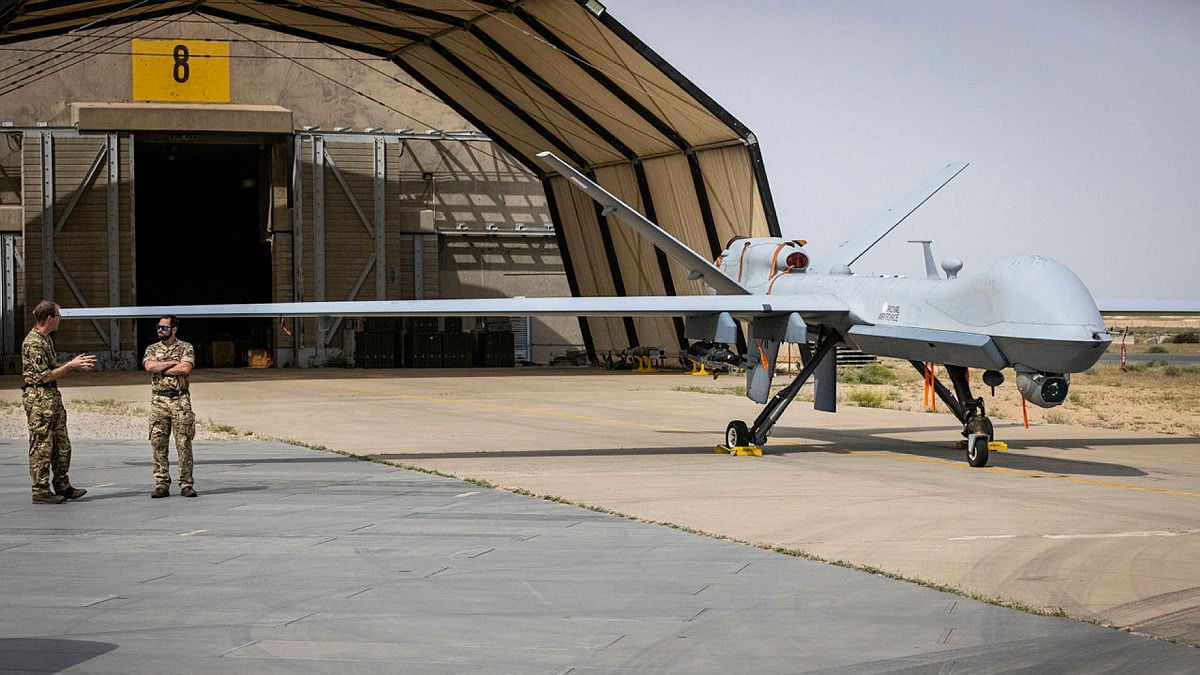TIM MARTIN
 BELFAST — The recent announcement by UK Prime Minister Rishi Sunak that his government will supply Ukraine with “hundreds of new long-range attack drones” despite not having any such known fleet of aircraft in regular inventory has sparked more than a little intrigue among defense analysts.
BELFAST — The recent announcement by UK Prime Minister Rishi Sunak that his government will supply Ukraine with “hundreds of new long-range attack drones” despite not having any such known fleet of aircraft in regular inventory has sparked more than a little intrigue among defense analysts.On May 15 Sunak said the drones have a maximum range of 200 kilometers (125 miles), but beyond that, the exact type of system or information about its capabilities have not been disclosed. The Prime Minister’s press office told Breaking Defense that it “wouldn’t be able to get into further detail.”
The lack of transparency on the matter stands out as British political and defense officials have been consistently open about military equipment sent to Ukraine throughout the conflict with Russia. Those items gifted by the UK include Challenger 2 main battle tanks, over 10,000 anti-tank missiles such as NLAW, Brimstone and Javelin, Storm Shadow long-range strike weapons, Multiple Launch Rocket Systems (MLRS), self-propelled guns, hundreds of armored vehicles and Starstreak short-range, man-portable, air-defense systems (MANPADS).
As for the mystery “long-range” drone, though, experts told Breaking Defense they’re not sure to what specifically the MoD might be referring.
“There’s nothing in the UK inventory that fits the long-range attack drone bill, so there’s really only two options that could explain this: an aircraft that the UK government has been working on and kept quiet, or something sourced from another country that the UK will fund and provide to Ukraine,” said Douglas Barrie, senior fellow for military aerospace at the UK-based International Institute for Strategic Studies (IISS) military think tank.
Discounting small or mini-sized drones and those with more exotic mission sets, the UK currently operates General Atomics MQ-9A Reapers, soon to be replaced with a MQ-9B SkyGuardian fleet, Thales Watchkeeper and QinetiQ Banshee drones. But none of those have been procured in the “hundreds” or are considered attack drones and only Watchkeeper, predominately an ISR asset and which has suffered a number of accidents in UK service, matches the 200-kilometer range profile.
If the long-range drone in question is a secretly developed system, it wouldn’t be the first to enter the Ukrainian conflict. In April the Pentagon made the surprise admission that it was sending previously undisclosed Phoenix Ghost drones to Ukraine. Very little information was released at the time, except that it was similar to relatively shorter-range loitering munitions and had been rapidly developed in partnership with the US Air Force.
There is confidence among analysts that the country possesses the industrial capability to readily design attack drones, even if the systems themselves are not part of any current acquisitions. That’s especially true if the drones are loitering munitions.
“The technology and manufacturing capabilities required to produce capable one-way attack UAVs are not particularly difficult,” said Justin Bronk, senior RUSI research fellow for airpower and technology. “Iran has shown this with its Shahed-136 and a wide range of other smaller examples like the Ababil-2 and Raad 85. Thus, it should not be surprising that the UK — which has been at the forefront of procuring and supplying urgently needed capabilities for Ukraine that do not form part of its own arsenal — should be able to rapidly design or procure and then produce such UAVs at scale for Ukraine.”
Bronk also said that while the accessibility and relatively low cost of producing attack drones “may have” received more attention because of their adoption by “rogue states and non-state actors,” more advanced states are just as capable of being able to develop them when required.
For Barrie’s money, he said it’s most likely the UK has purchased an off-the-shelf, readily available UAV in what’s a burgeoning market.
James Rogers, a professor in war studies at the Danish Institute for Advanced Study, cautioned that whatever the UK is referring to, the “long-range” part requires especially careful evaluation, especially as the US and NATO seek to avoid escalation of the conflict beyond Ukraine’s borders. (For context, the American-made Reaper has a max range of over 1,000 miles, several times the distance of the mystery drone.)
“I’m not entirely sure where these UK drones are coming from or when they will be delivered and we really need to look at the details from Rishi Sunak and to what extent these are ‘long-range’ drones…,” he said. “We should not get carried away with hyperbole and add to the rhetoric which seems to suggest that the UK is supplying Ukraine with weapons that will afford it the ability to carry out precision strikes in Russia itself, which is just not the case. it’s certainly not something we want to be suggesting we are doing as a NATO power.”
There has been no indication from UK government officials that the long range drones will be used to strike Russian territory.
“The United States has quite clearly put forward that it will not be sending long-range weapons to Ukraine for that very reason,” he said. “It doesn’t want to escalate matters to the point where NATO countries are training Ukrainian personnel and supplying them with actual long-range weapons systems that will then be used against Russia, that situation is very much an escalation.”
No comments:
Post a Comment